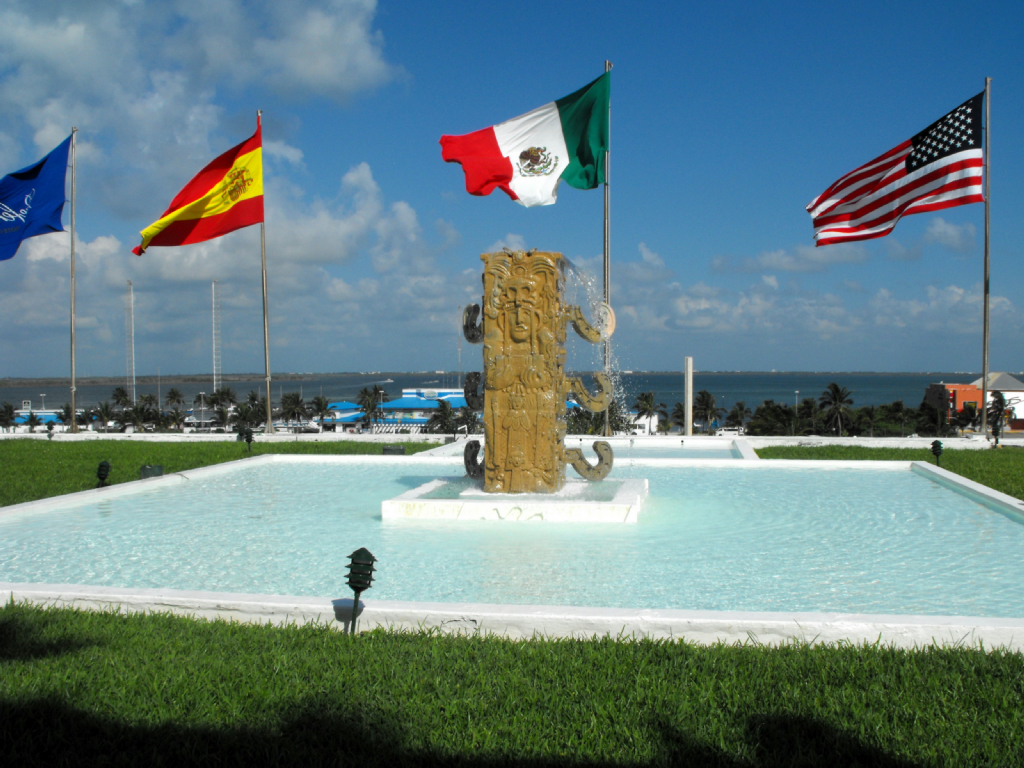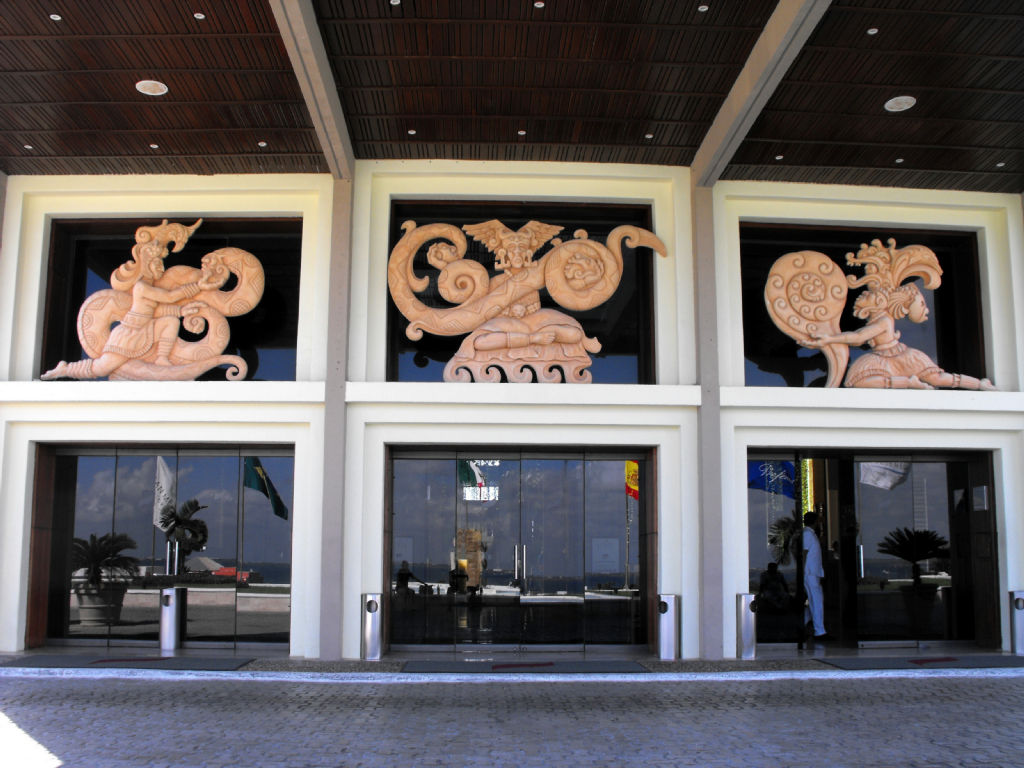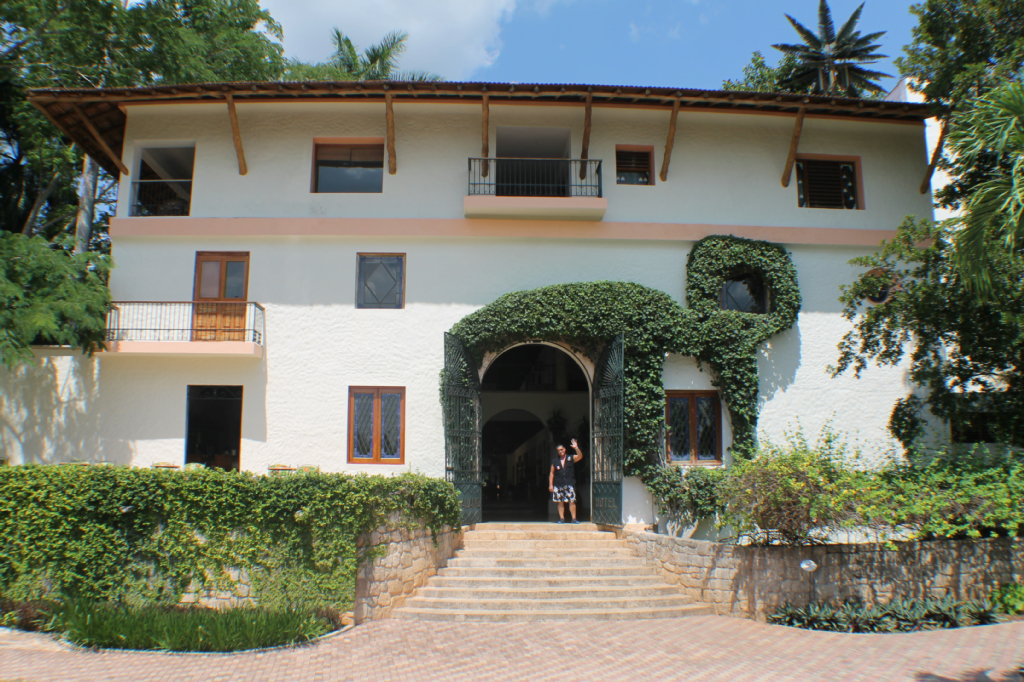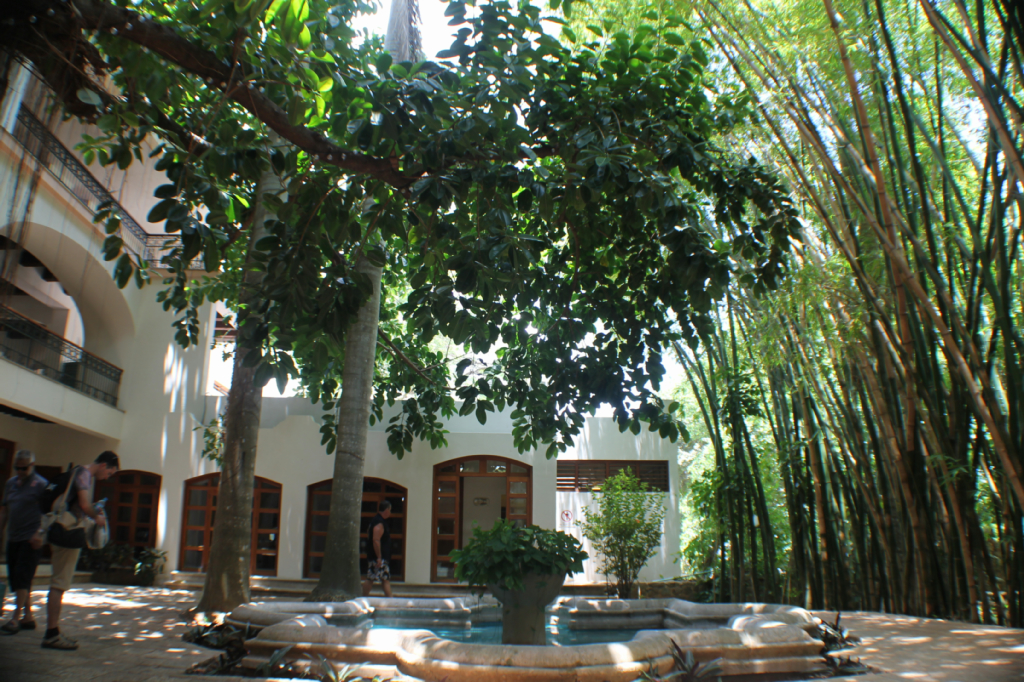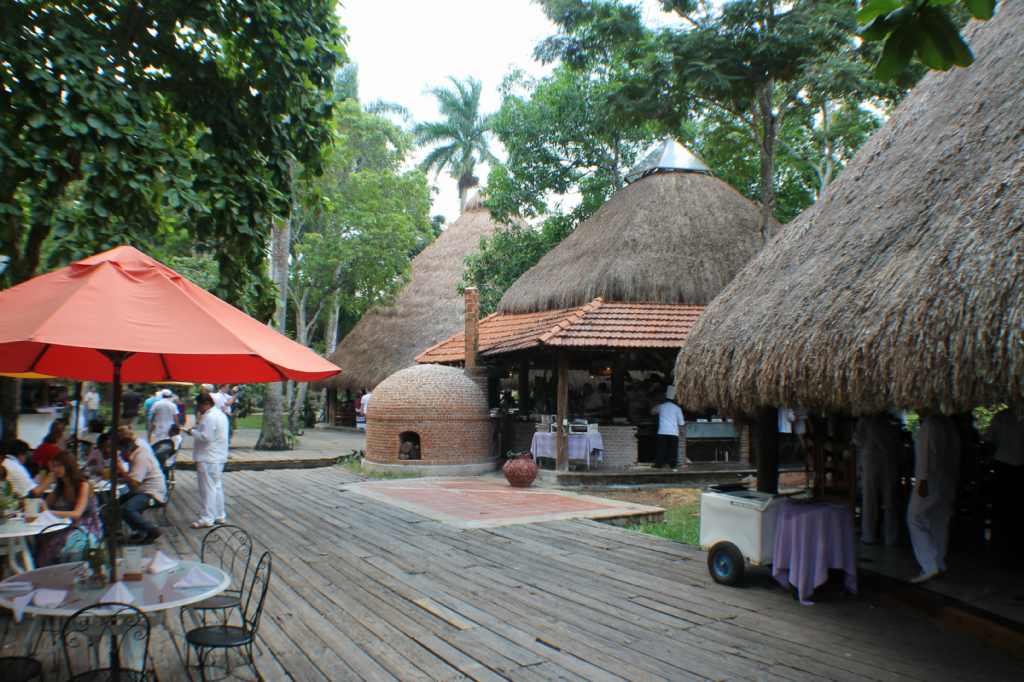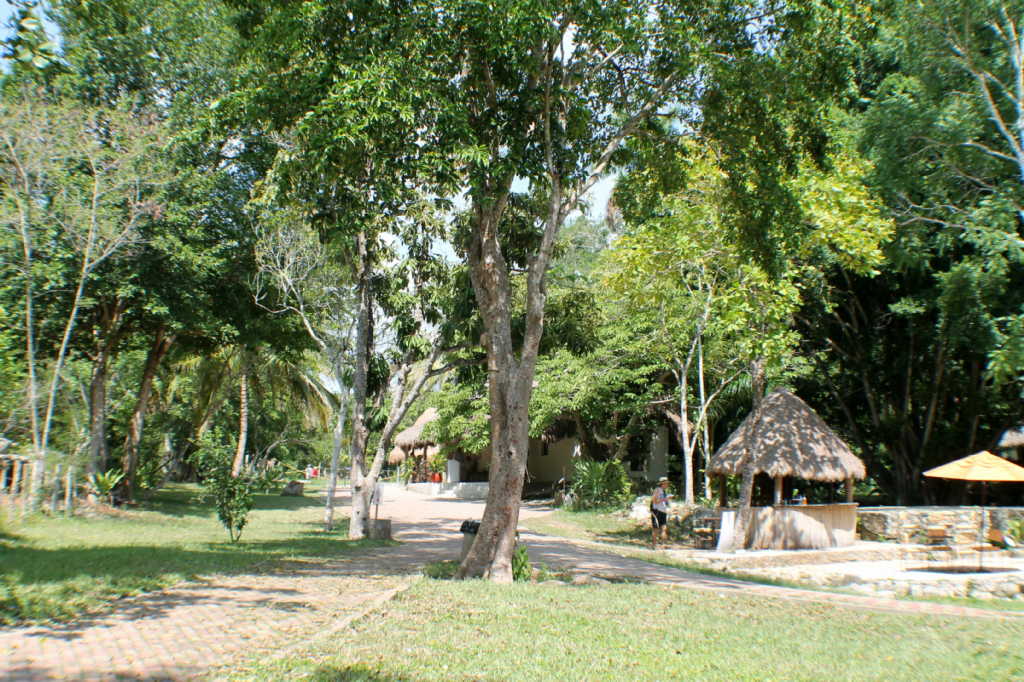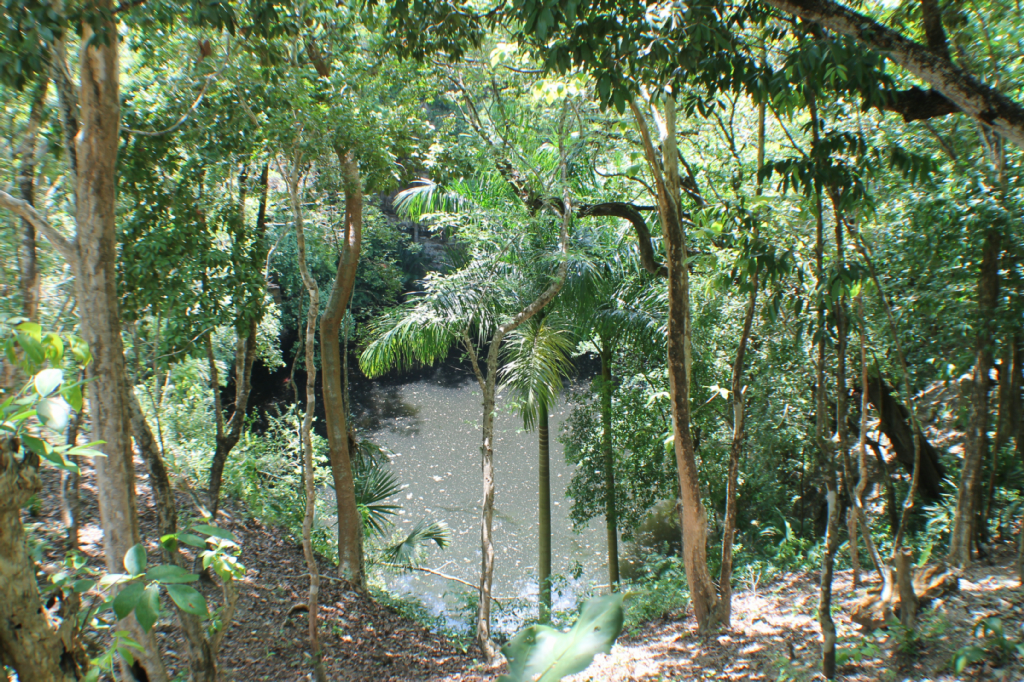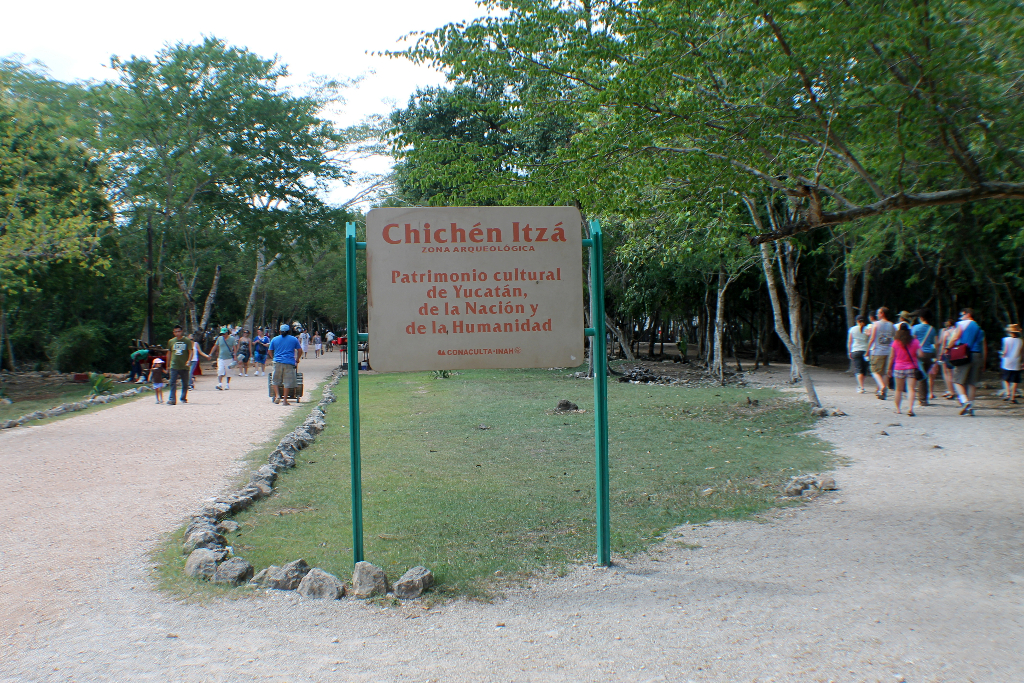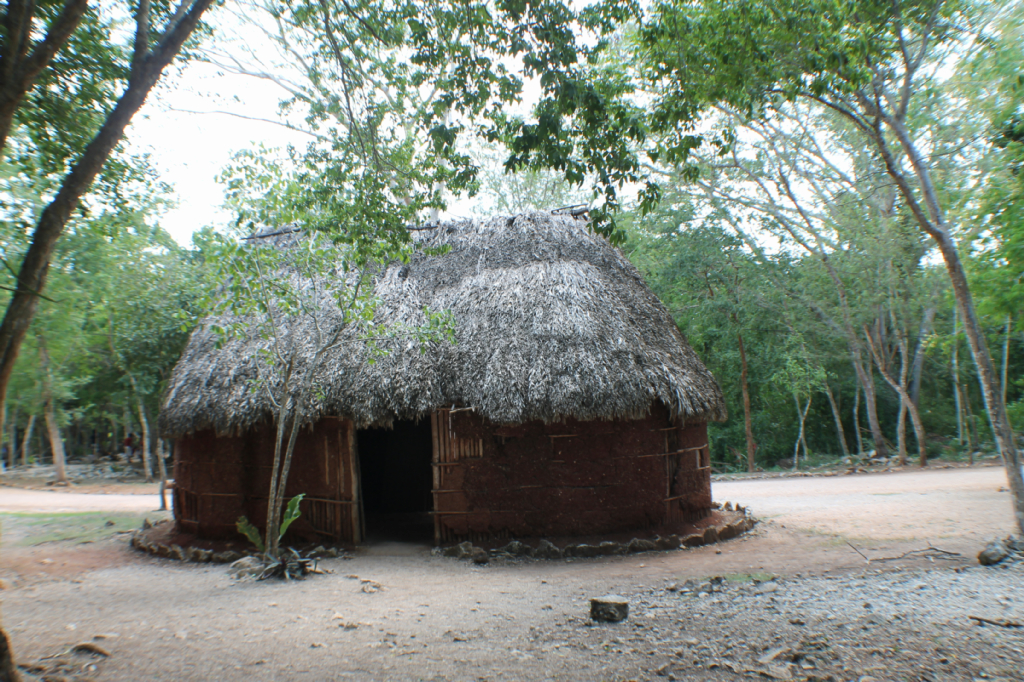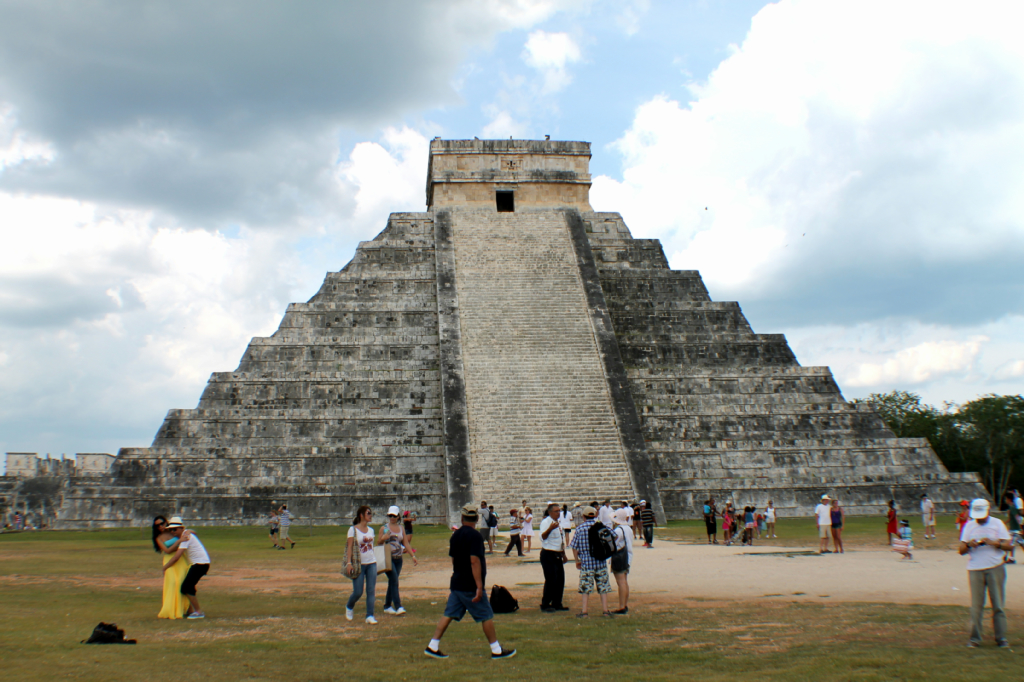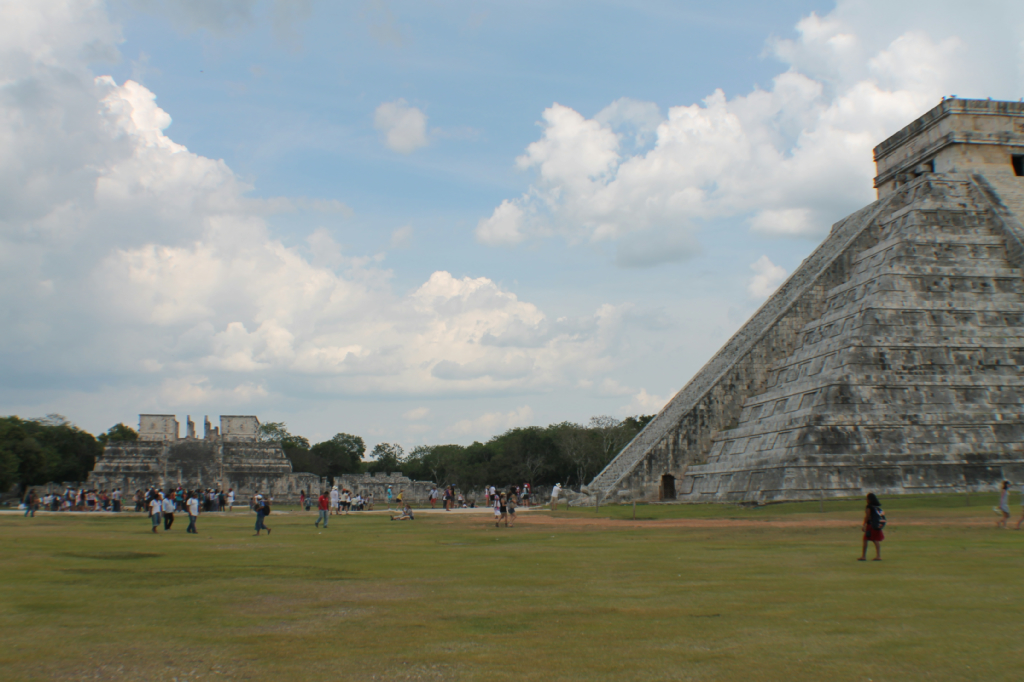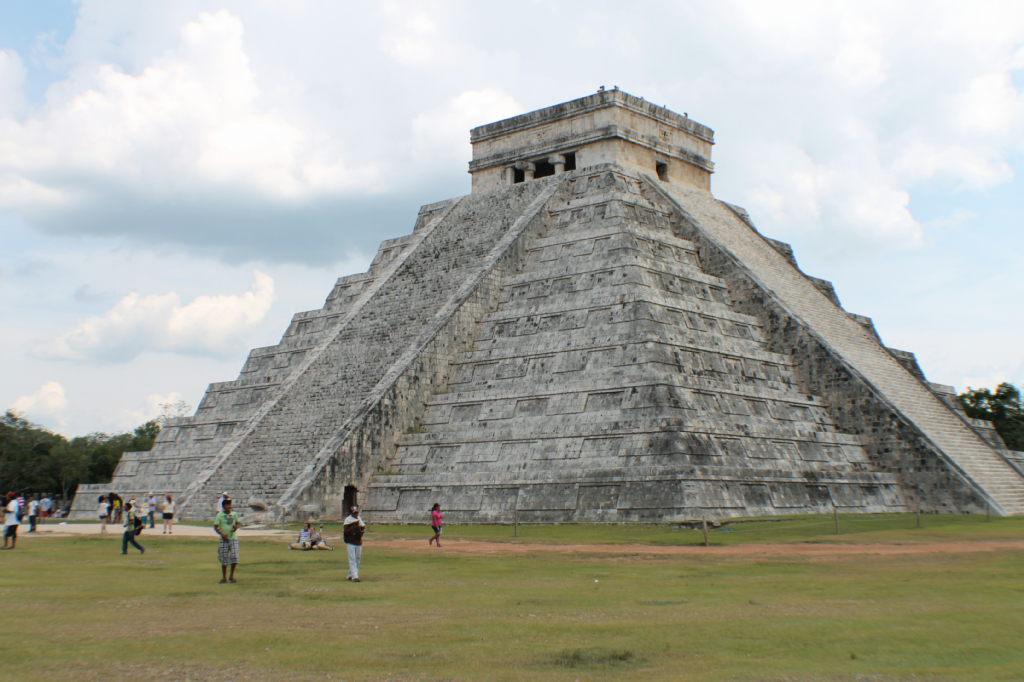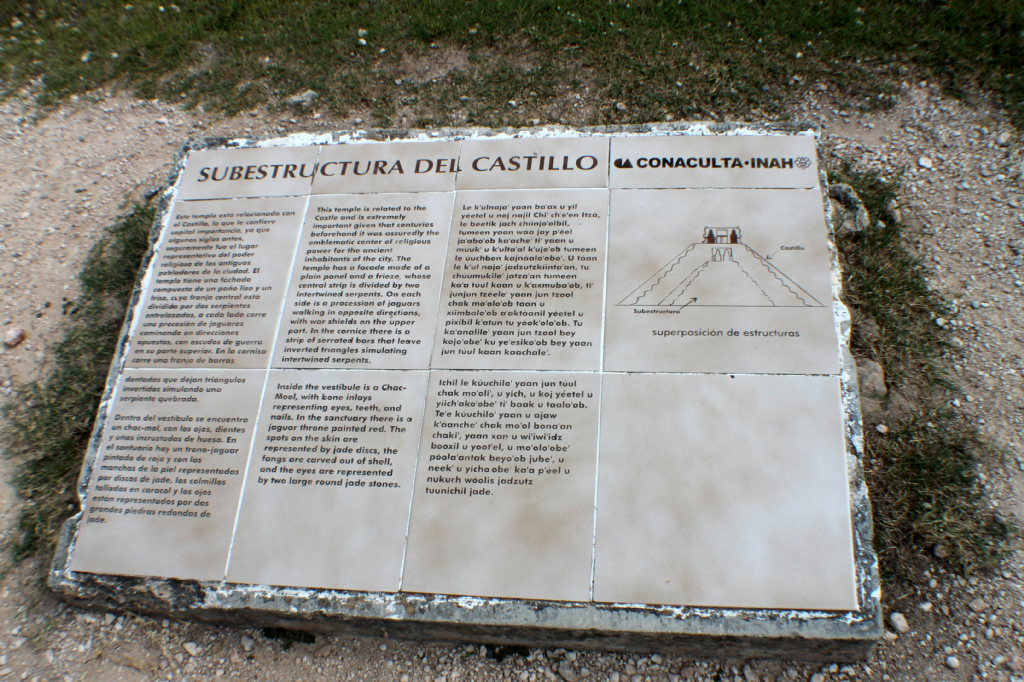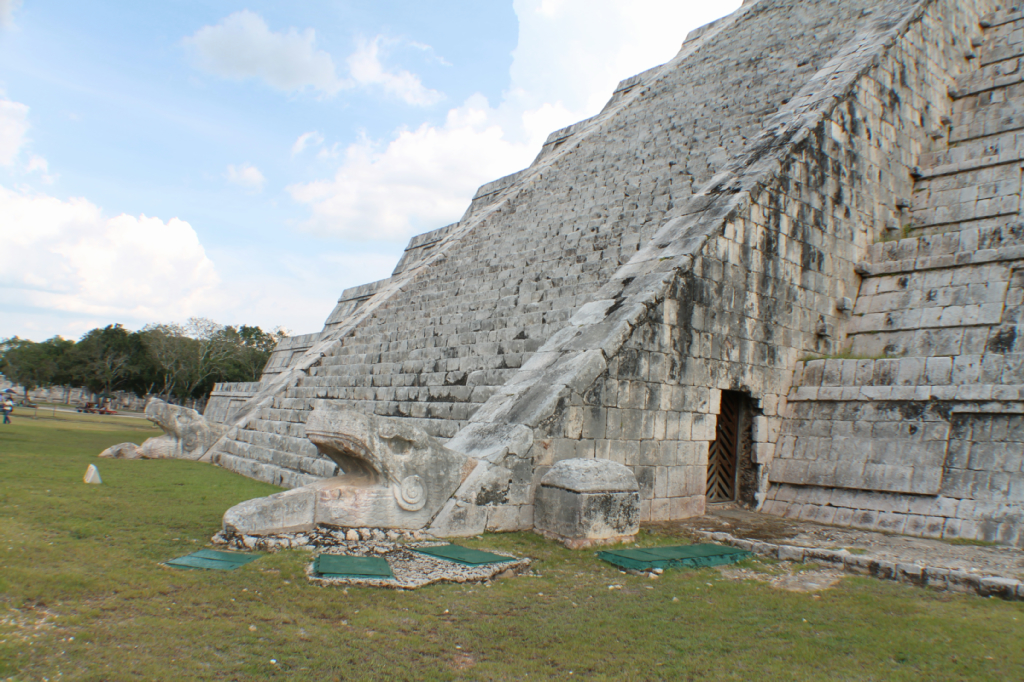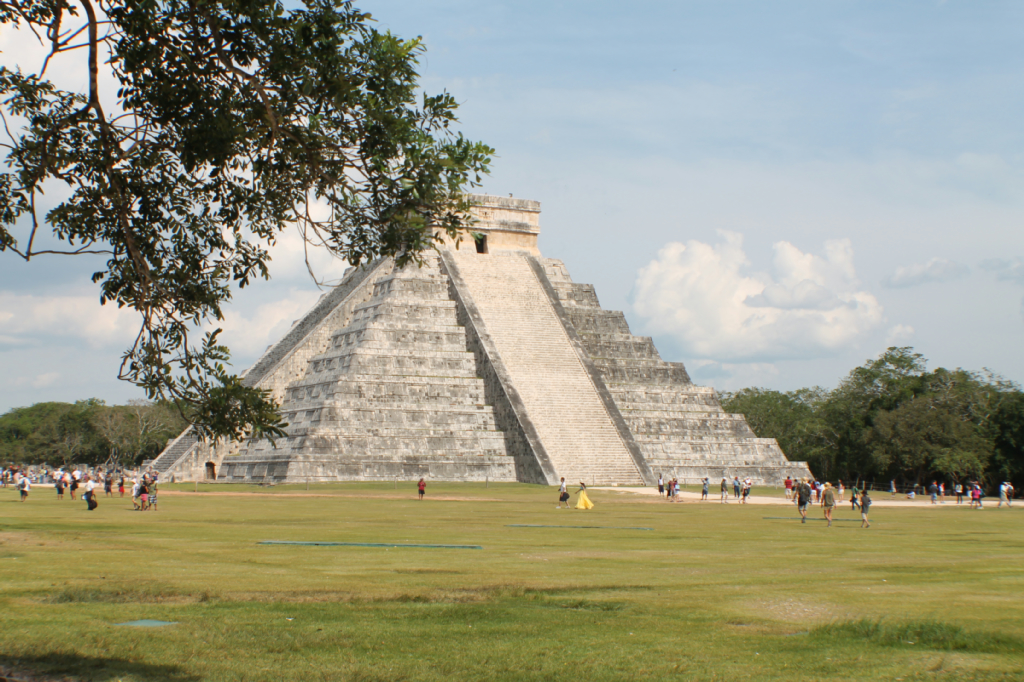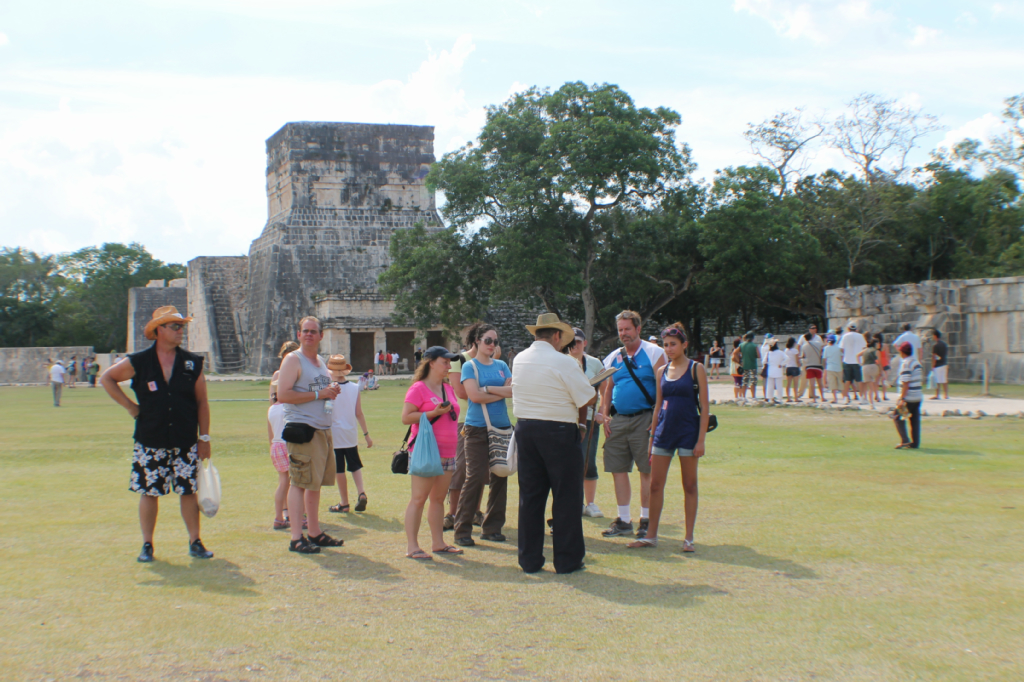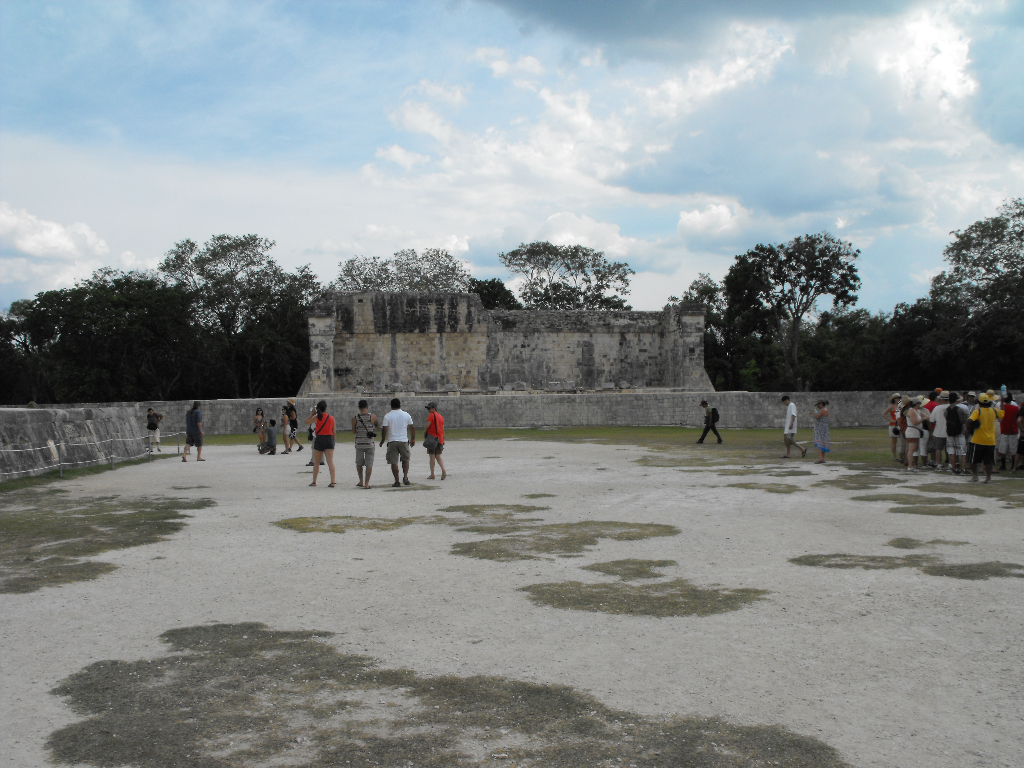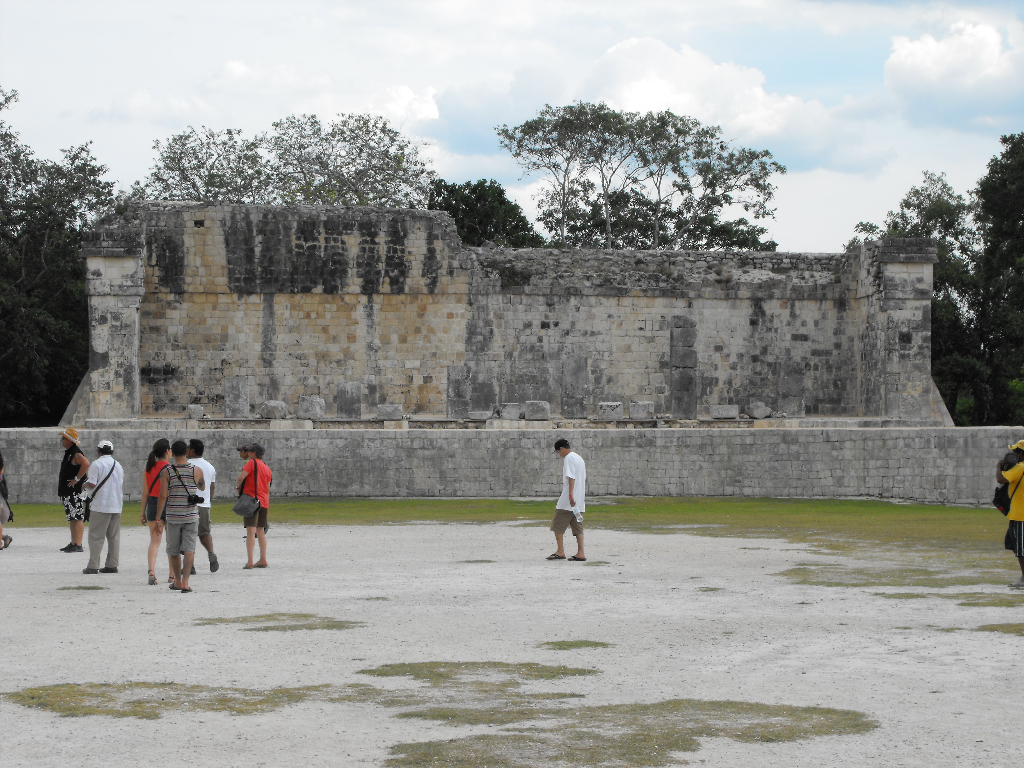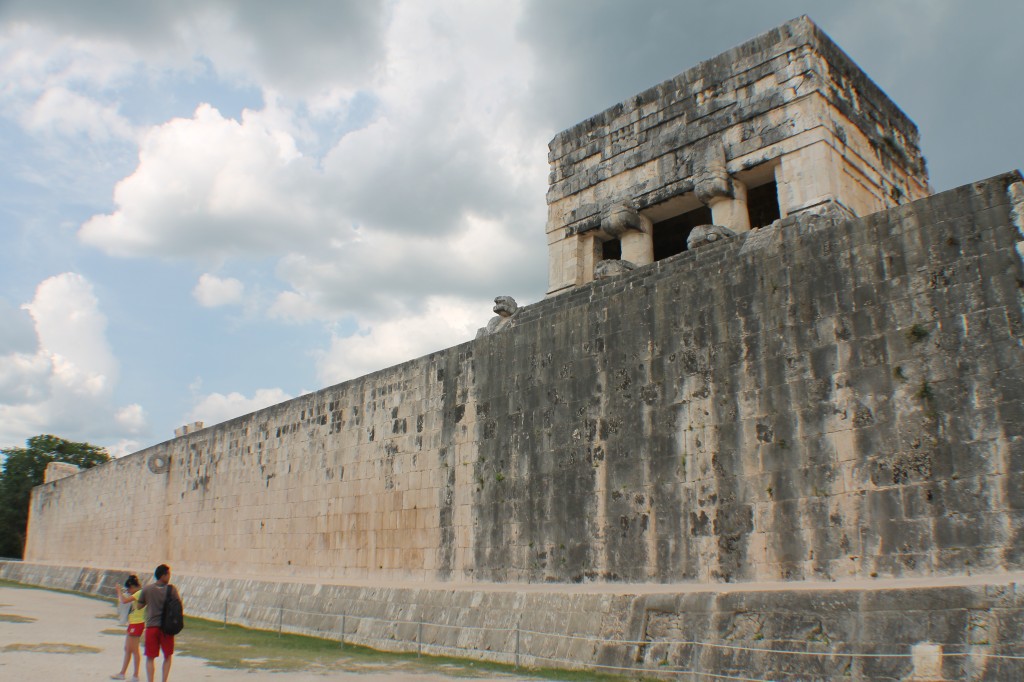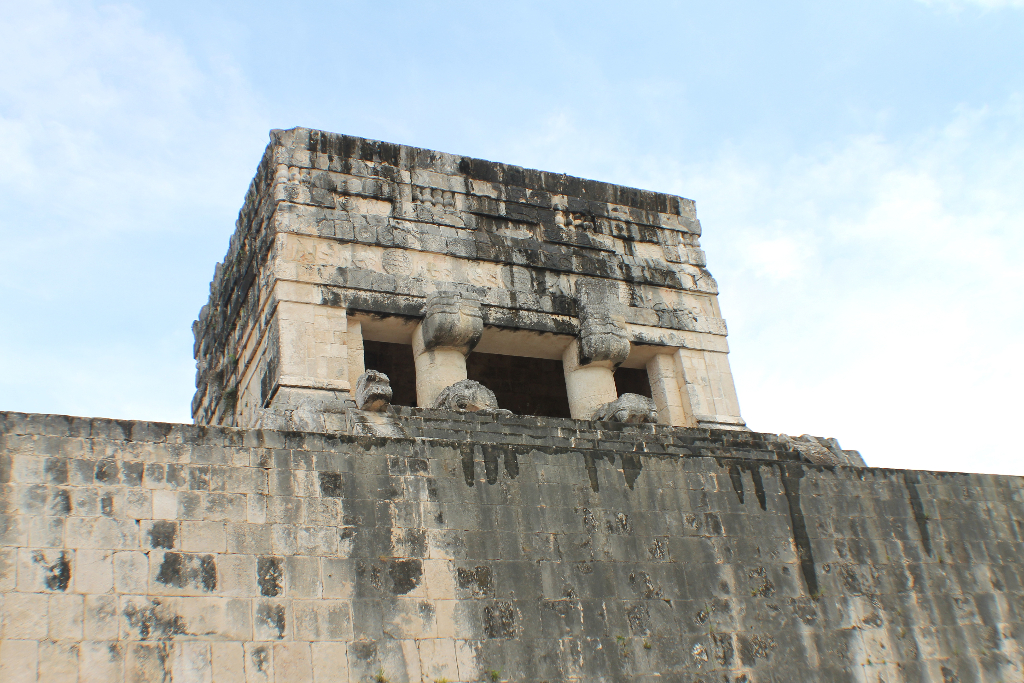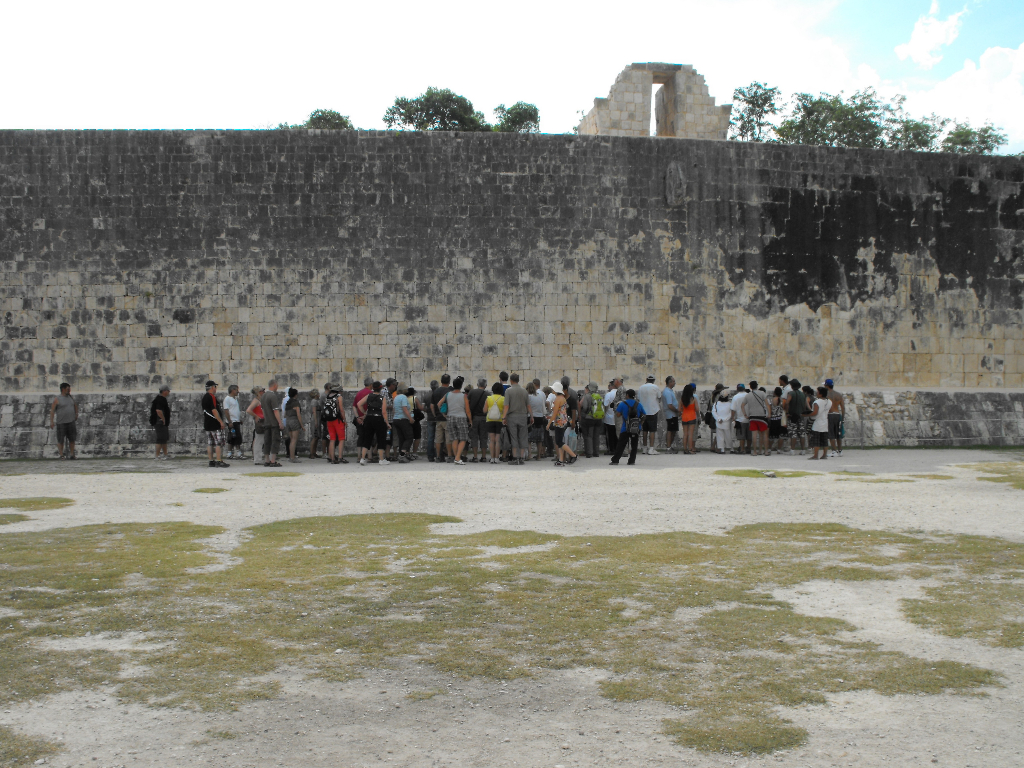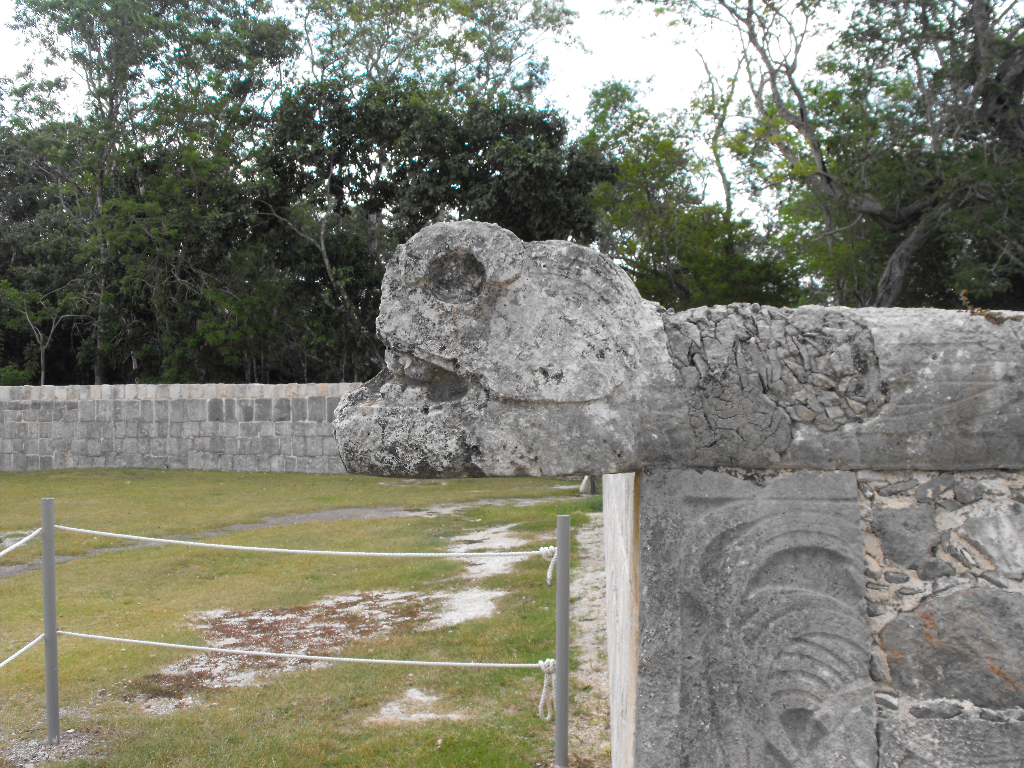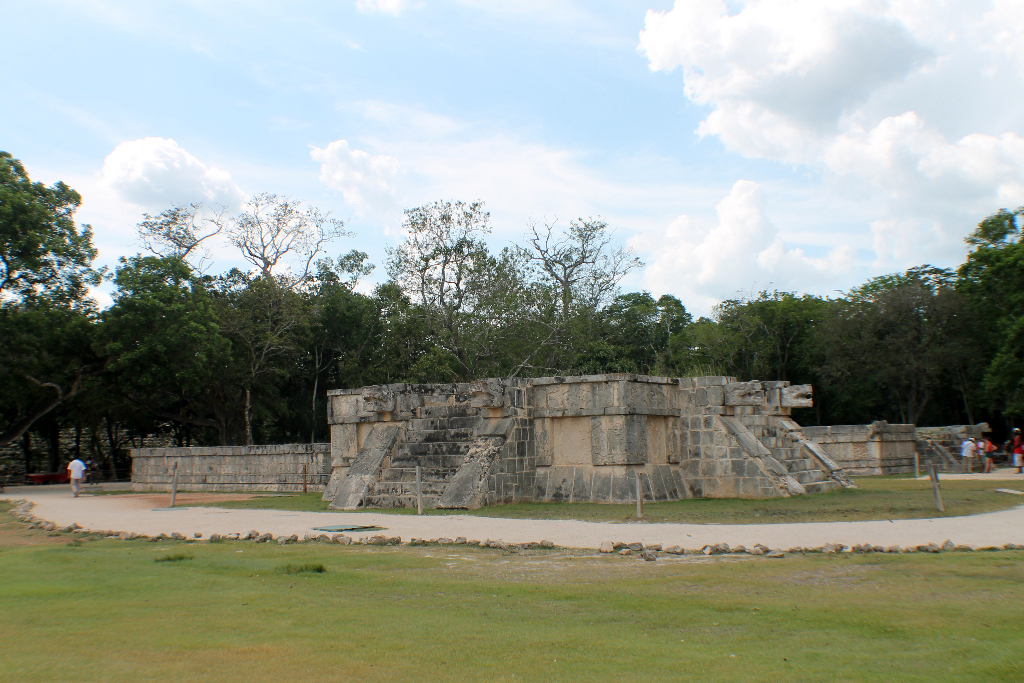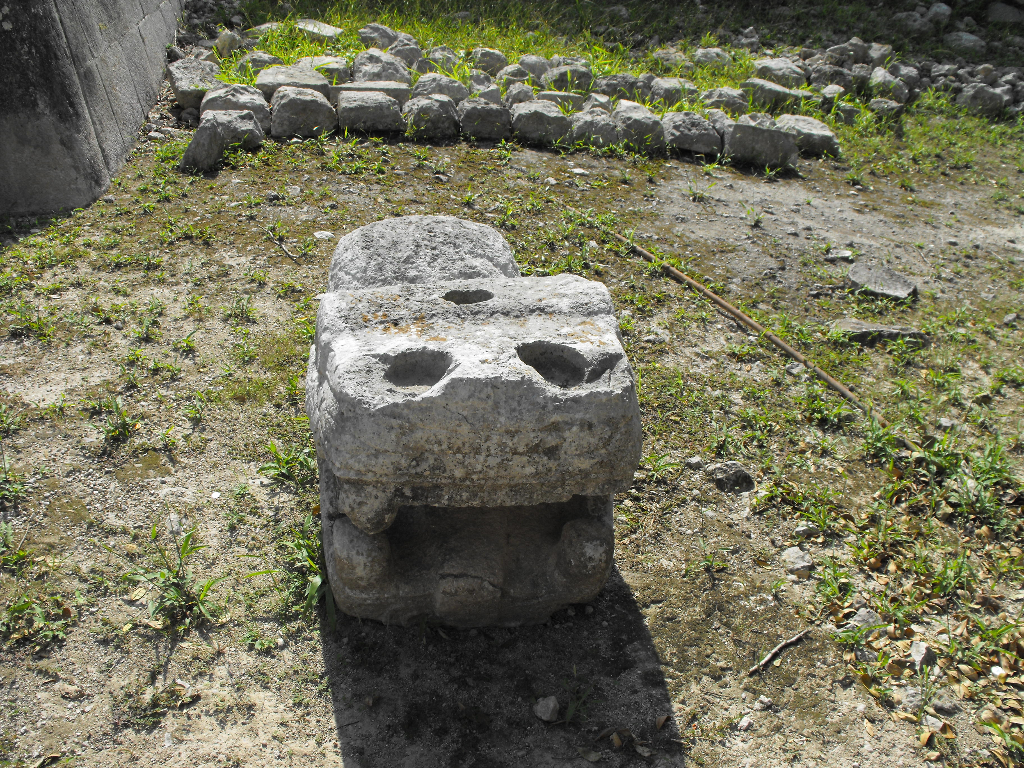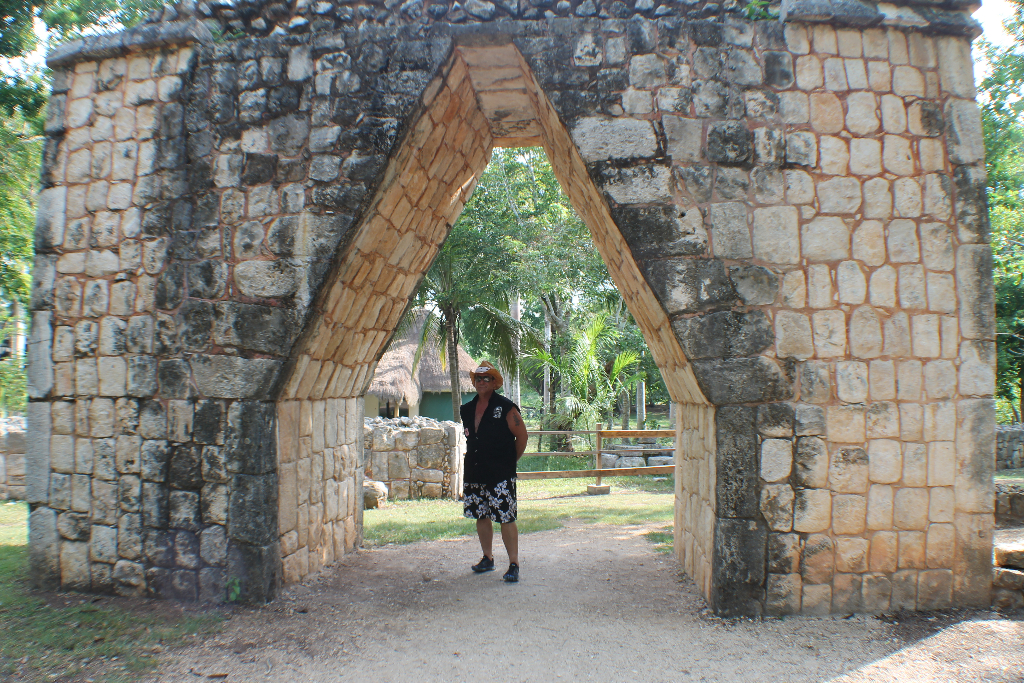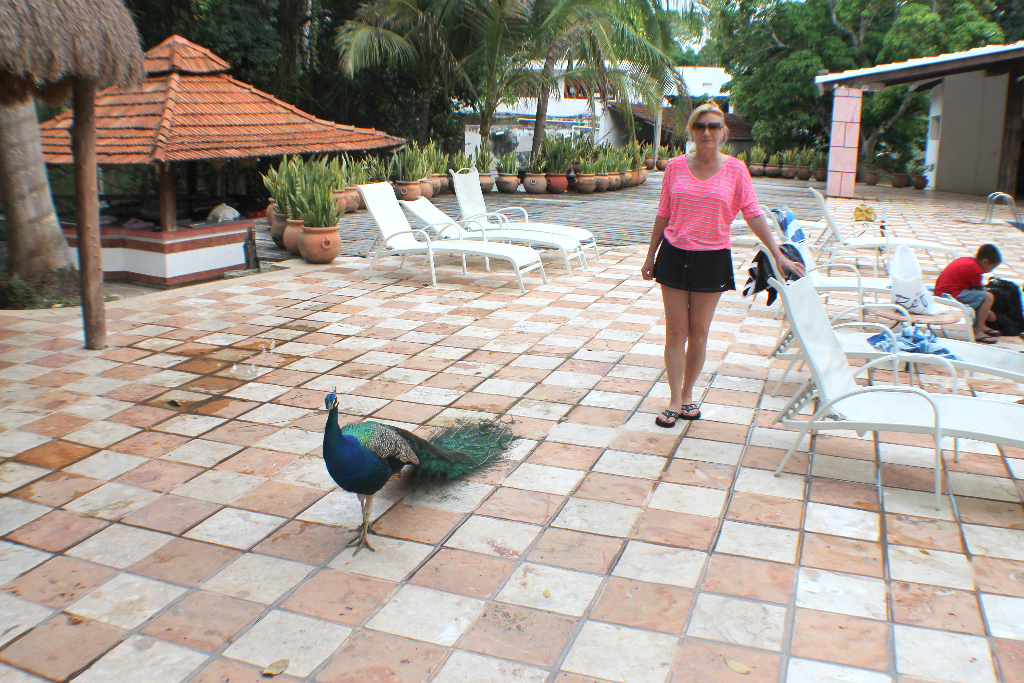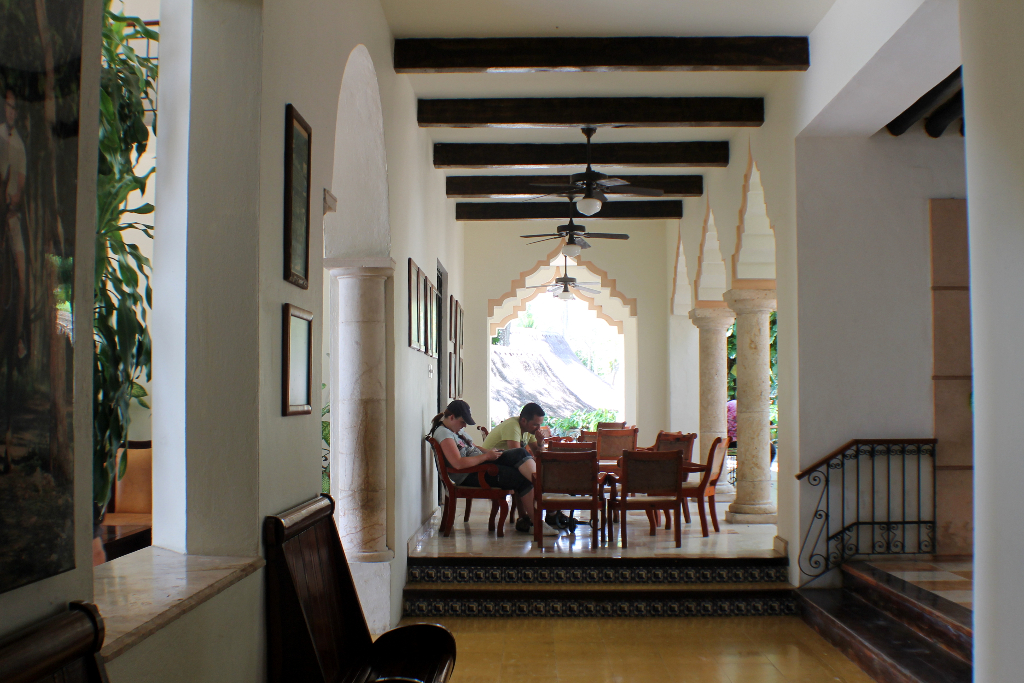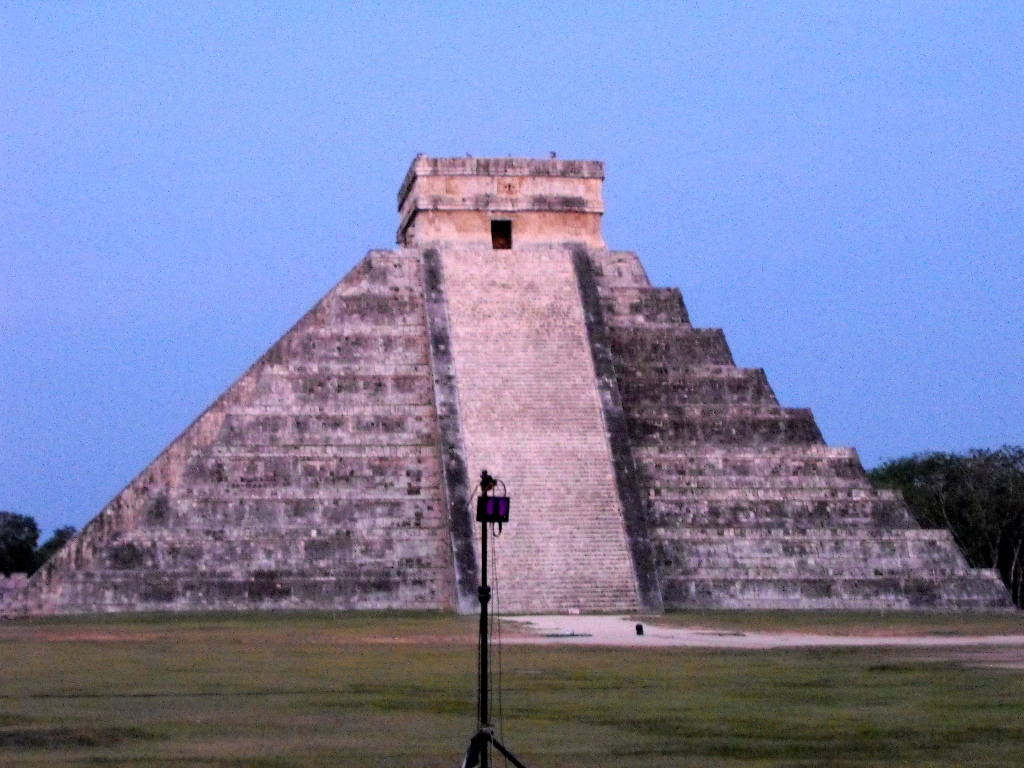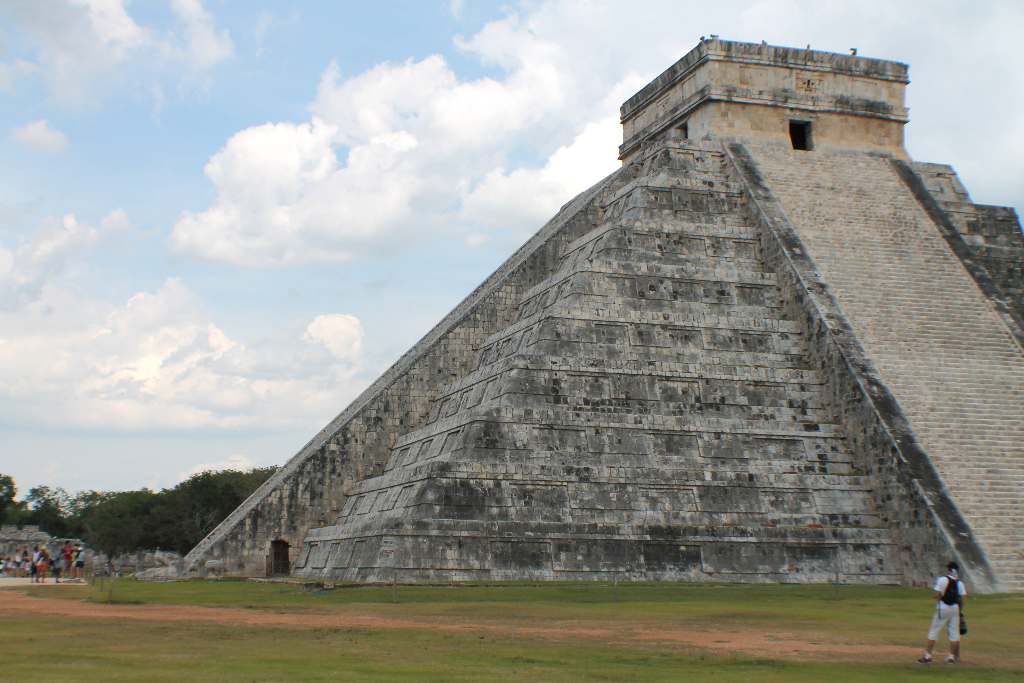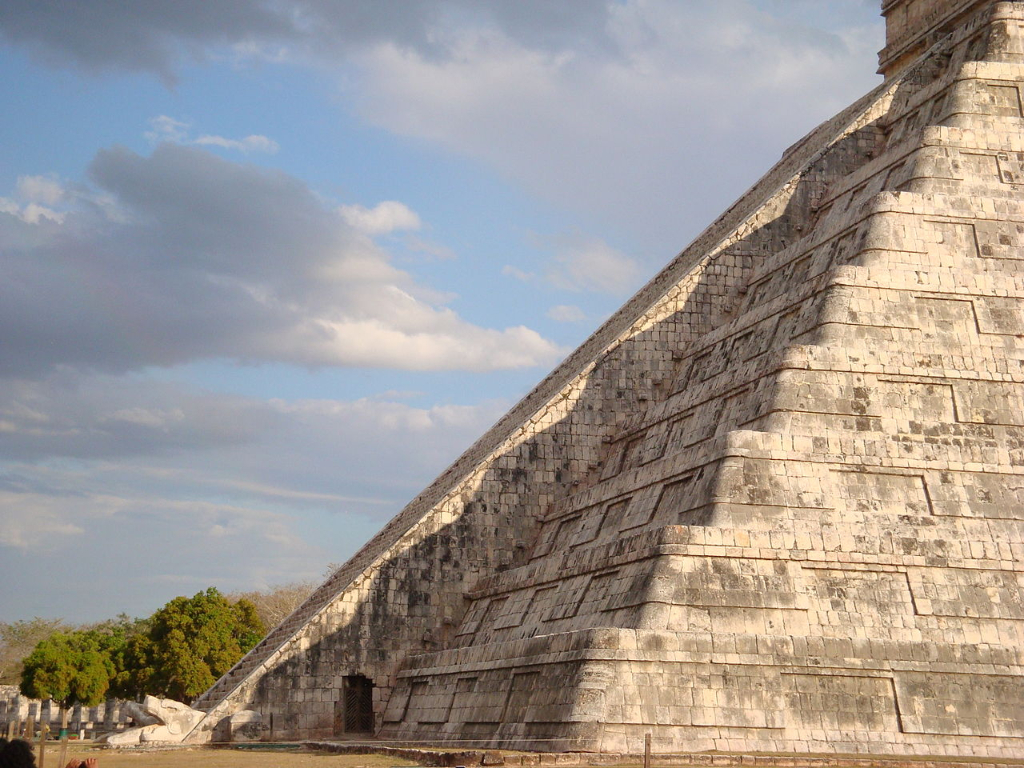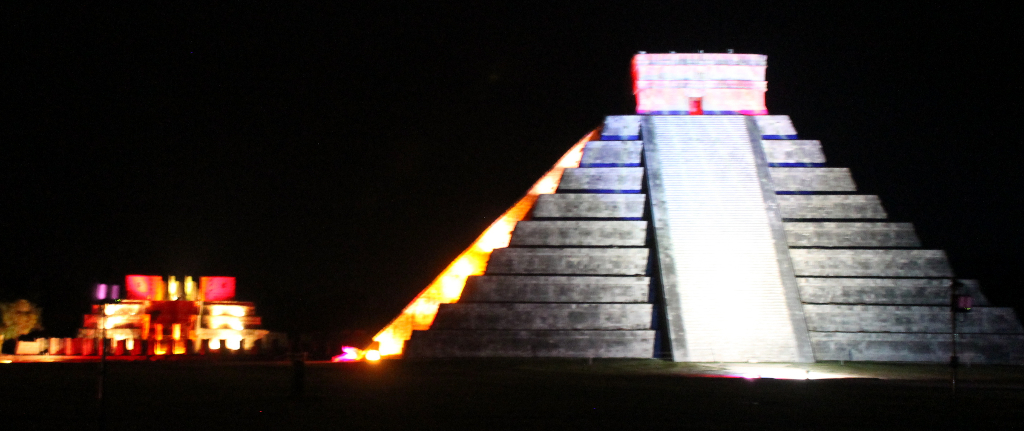I had to upload this post, because tomorrow “the End of the World” is expected. 🙂 I just heard over the radio, that the marketing strategy really works and the tourists flooded the Yucatan Peninsula. We visited the Mayan ruins this summer and the mystery of the Mayan Apocalypse has been explained to us. Let’s follow our journey to the ancient Mayan world.
It was a beautiful sunny morning in Cancun, Mexico. Dave and I were enjoying our coffee outside of the hotel’s entrance, while waiting for our transportation to arrive. On this day we were going to visit the ancient Mayan city of Chichen Itza. Chichen Itza is considered the largest of the ruined Mayan cities on the Yucatan Peninsula and one of Mexico’s most-visited tourist destinations. Construction of the city began in the 7th century and the city reached its peak in the 10th century. Nichupte Lagoon is seen right behind the fountain from the entrance of our hotel.
The entrance to the Gran Melia hotel, where the tourist buses arrive. By the way, the buses always arrived on time. 🙂
It took us abut 3 hours to get to Chichen Itza archaeological site from Cancun, because we had to pick up other tourists from other hotels. Our tour guide was feeding us valuable information about this ancient Mayan city during our entire ride. Here is the picture of the agave field which we saw on our way. As we all know, agave is the main ingredient for the best tequila products.
Finally, we have arrived to Mayaland hotel, where we were planning to have lunch, which included authentic Mayan food and visit Chichen Itza after that. Followed the break, during which we could use hotel’s facilities, we would visit a Light and Sound show at Chichen Itza again.
Entering Mayaland hotel located in the heart of the archaeological park of Chichen Itza.
The Mayaland Hotel has an attractive courtyard with a lovely fountain.
A interesting tree was right in the hotel’s courtyard.
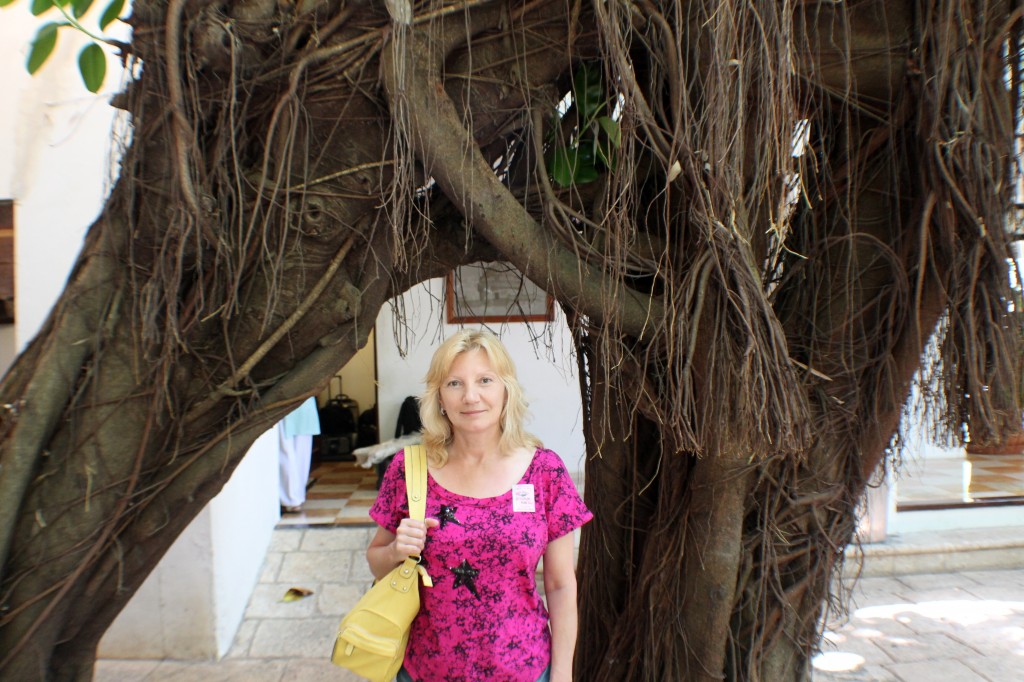
Mayaland Grounds.
Buffet style lunch was delicious with nice selections.
At the Mayaland hotel.

Mayaland resort has its own entrance into the ruins of Chichen Itza with the small Visitor Center, which is straight ahead in the picture. There are restrooms, a gift shop, and vendor stands. Admission tickets for foreign adults is 166 pesos (US$16). A self-guided audio walking tour is available here as well.
Arch at the entrance to Chichen Itza.
Our walking tour of Chichen Itza began from the Visitors Center to the Main Plaza. Chichen Itza means at the mouth of the well of the Itza: “Chi” means mouth, “Chen”means well, and Itza is an ethnic group. It was a large pre-Columbian city built by the Maya civilization and a major focal point in the northern Maya lowlands from the period of (c.600–900 AD) to (c.900–1200). The city may have had the most diverse population in the Maya world, a factor that could have contributed to the variety of architectural styles at the site (from wikipedia).
Our first stop was at the Xtoloc Cenote. There are two cenotes in Chichen Itza: the Sacred Cenote, which is the largest and most impressive of the two, and the Xtoloc cenote. This cenote is named after the Maya word for iguana Xtoloc and it is the other large cenote at Chichen Itza. The Xtoloc Cenote provided water, while the Cenote Sagrado or Sacred Cenote was used primarily for ceremonial purposes, including human sacrifice.
According to Internet sources, the Chichen Itza archaeological zone covers 2 ½ square miles and was placed on the UNESCO World Heritage List in 1988, when the United Nations recognized that the Mayan ruins possessed a “cultural and natural heritage having outstanding universal value.” In 2007, Internet voters worldwide selected Chichen Itza as one of the New Seven Wonders of the World.
One of the numerous souvenir stands is at the entrance from Mayaland hotel. The presence of aggressive souvenir vendors at Chichen Itza is annoying and considered at least a distraction by almost all visitors. Although they sell some cute and inexpensive souvenirs. 🙂
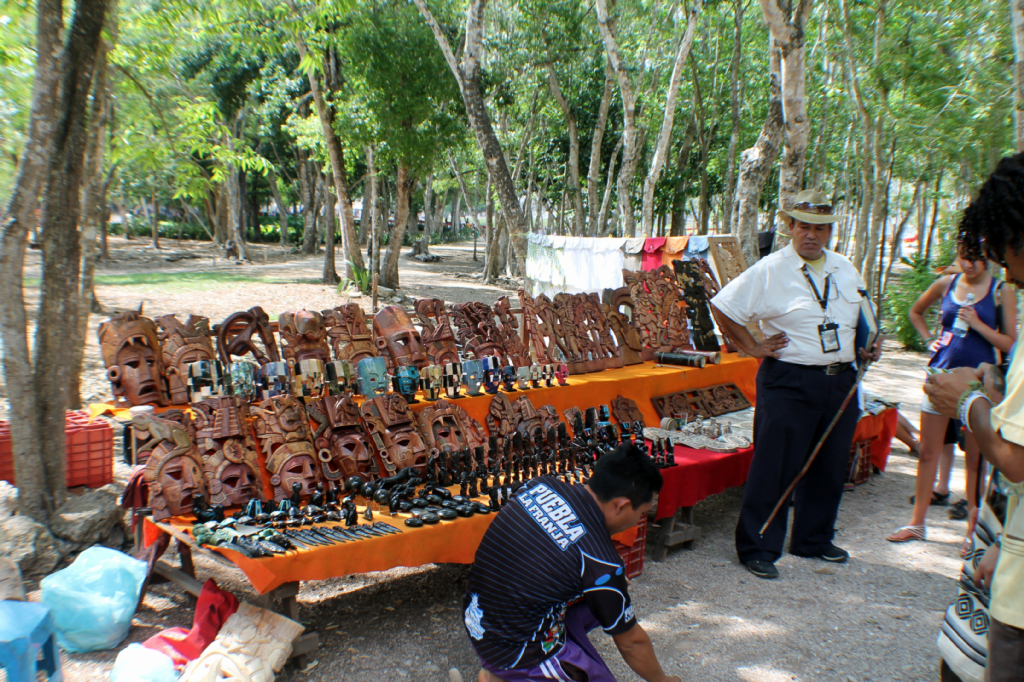
The Mayan Hut. The reconstructed hut below shows where common people lived. The Maya commoners tilled the land and performed all the services the elite needed and wanted.
Approaching one of the most impressive monuments of Chichen Itza – the towering pyramid El Castillo (the Castle) or the Pyramid of Kukulcan, dedicated to the feathered serpent god Kukulcan (snake). The unfinished side of El Castillo is on the right side of the picture.
The architecture of El Castillo is believed to have some significance in the Maya Calendar. The four stairways leading up to the central platform each have 91 steps, making a total of 364; added to the central platform this equals the 365 days of the solar year. On either side of each stairway are nine terraces, which makes 18 on each face of the pyramid, equaling the number of months in the Maya solar calendar. On the facing of these terraces are 52 panels, representing the 52-year cycle when both the solar and religious calendars would become realigned. The pyramid is 30 meters/98 ft. tall, and 55.3 meters/181 ft. across. The structure is built in 9 platforms, that correspond to the Maya conception of a nine-stage underworld. The ancient Maya were great astronomers, mathematicians and architects. They utilized all of these sciences to express their mystical world-view (from wikipedia).
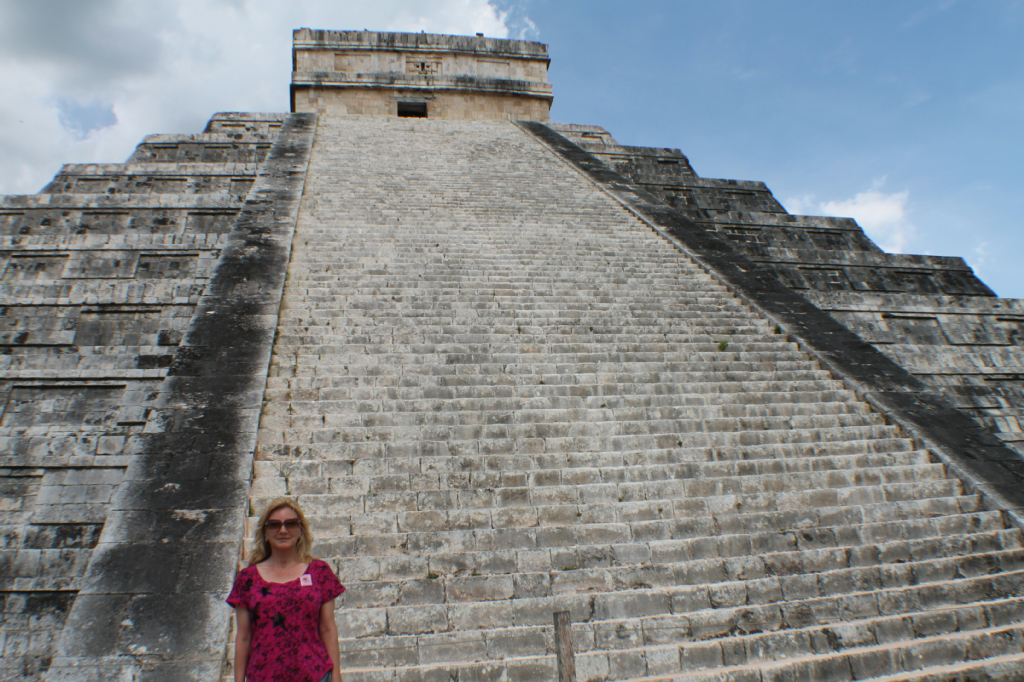
We tested El Castillo’s famous acoustics by standing in front of the pyramid and making a single hand clap results in an echo from the pyramid’s staircase, an echo which sounds like the downward chirp of a bird. Unfortunately, it has not been possible to climb El Castillo since 2006 when an 80-year old woman slipped and fell to her death. Other sources state that the reason for not allowing to climb the pyramids is to preserve the ancient monuments.
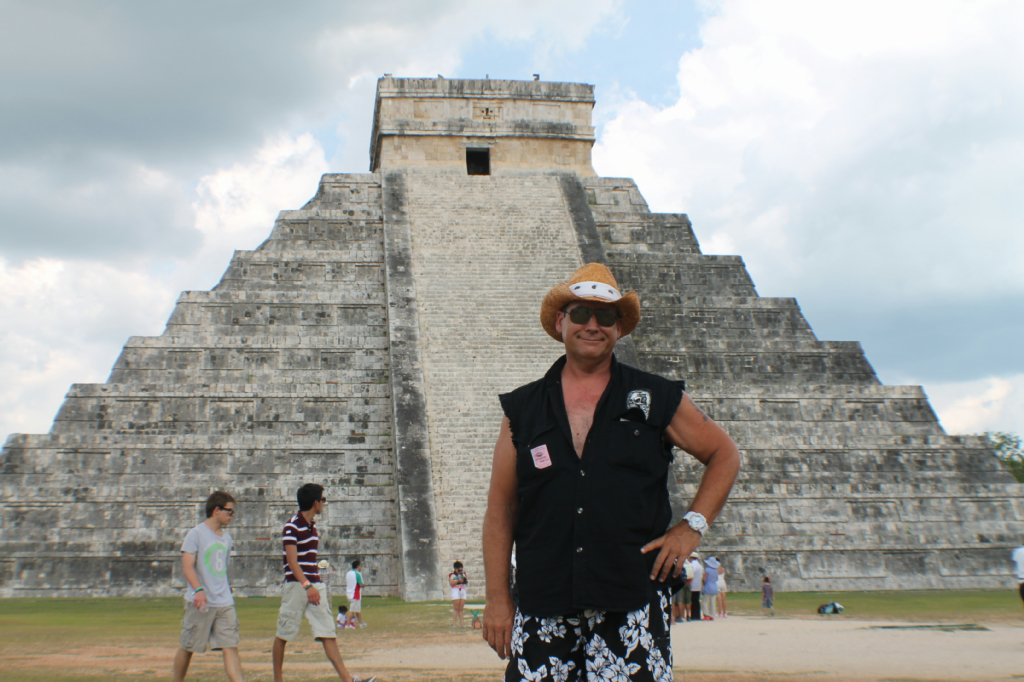
The Front view of the Temple of Warriors. The Temple stands a short distance away from El Castillo also known as the Pyramid of Kukulcan, and across the central plaza from the Ball Court. Unfortunately, we ran out of time to see the Temple of Warriors closer.
Sculptures of the Feathered Serpents run down the sides of the northern staircase of the Kukulcan pyramid. They are aligned in the way that a special effect occurs on the spring and fall equinox. On these two days, the sun light and the shadow form a diamond pattern resembling the snakes. The picture of the pyramid during equinox can be viewed at the end of this post.
There is the tablet/sign a short distance from the serpent head.
El Castillo Feathered Serpents.
The front view of the northern staircase of the Kukulcan pyramid with the descending serpents.
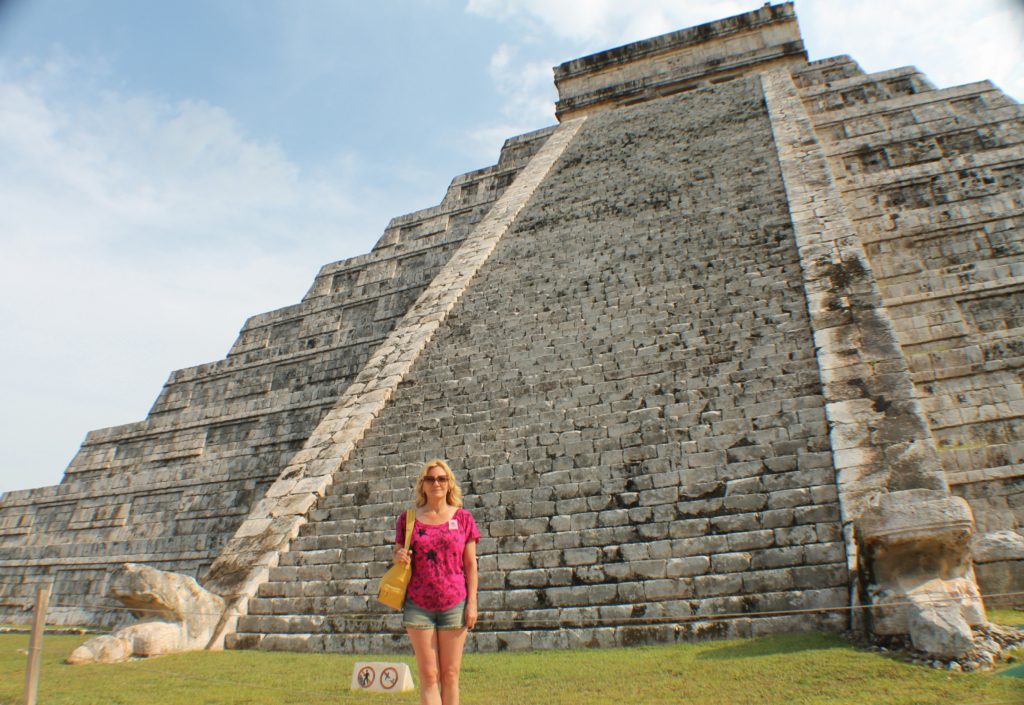
The other view of the Kukulcan Pyramid. This Pyramid is so mystical and perfect, that I couldn’t take my eyes off it.
The 0uter view of the Great Ball Court. It is the grandest of 1,300 ball courts uncovered in Mesoamerica. Several temples were placed on the walls surrounding the ball court: the small North Temple or the Temple of the Bearded Man at the northern end, the larger South Temple to the south, and the two-story temple on the eastern side of the ball court that consisted of the Upper and Lower Temples of the Jaguar.
Our group is moving towards the Temple of the Jaguar. This temple and the structure around it form one wall of Chichen Itza’s ball court as in the picture above.
The Temple of the Jaguar has some basis for its name. Jaguar-shaped thrones, which are associated with city leaders, were found inside. The Jaguar Temple has a single chamber and a bottle-shaped vault. The Lower Temple of the Jaguar, seen here, faces out into the main plaza of Chichen Itza. The upper tower is overlooking the Grand Ball Court and has a better view from the inside of the Ball court.
The lower temple has a jaguar throne and stone carvings on the walls. The Jaguar Throne below is a seat shaped like a jaguar presumably made for some of the rulers. This is the only one left at the site open to the public. The remainder are in museums, because they are often richly painted with inlaid shell, jade and crystal features.
The Great Ball court is 166 meters/545 feet long and 68 meters/232 feet wide. It is far larger than today’s American football field. The Great Ball court is not only the biggest one, but also is the best preserved court discovered in Mesoamerica. Three of its sides are part of temples, which were, most likely, used for rituals during the games. There are many legends about the ritual game played here. It is believed that players propelled a heavy rubber ball without using their hands or feet, bouncing it off their hips or shoulders and through one of the rings on either side of the court. The scenes of the rituals are depicted in carvings and decorations on the ball court walls. One of its most famous panels depicts the beheading of a player. It is not clear if the sacrificed player was a member of the losing team, or the best player of the match (a much better offering to the gods). There is the North Temple, also known as the Temple of the Bearded Man on the back of the picture .
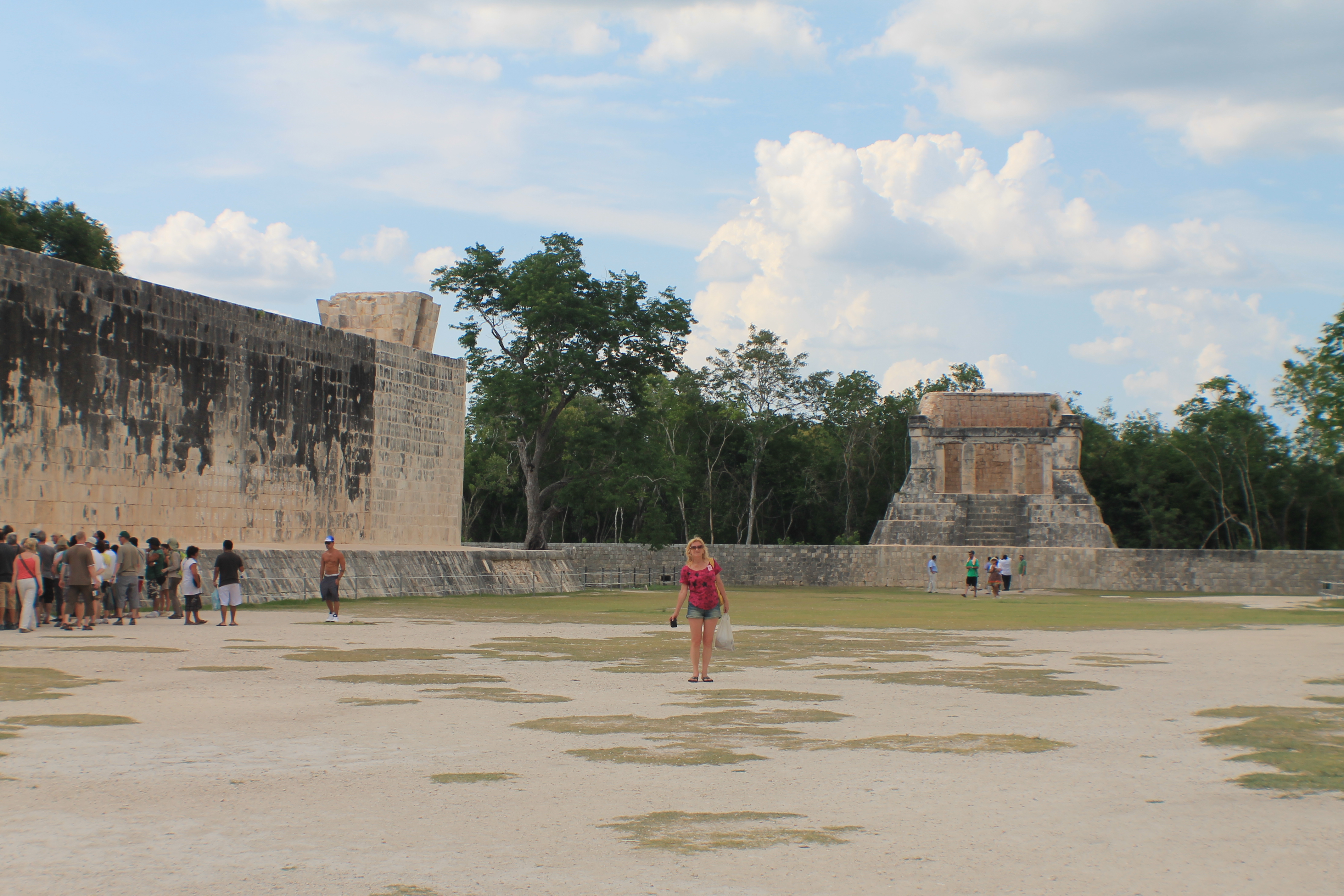
Stone Ring at Ball Court. Scoring involved propelling the ball through this ring. The ring is mounted 6 meters/20 ft above the ground, and the hole is a bit smaller than a soccer ball. Not an easy game…
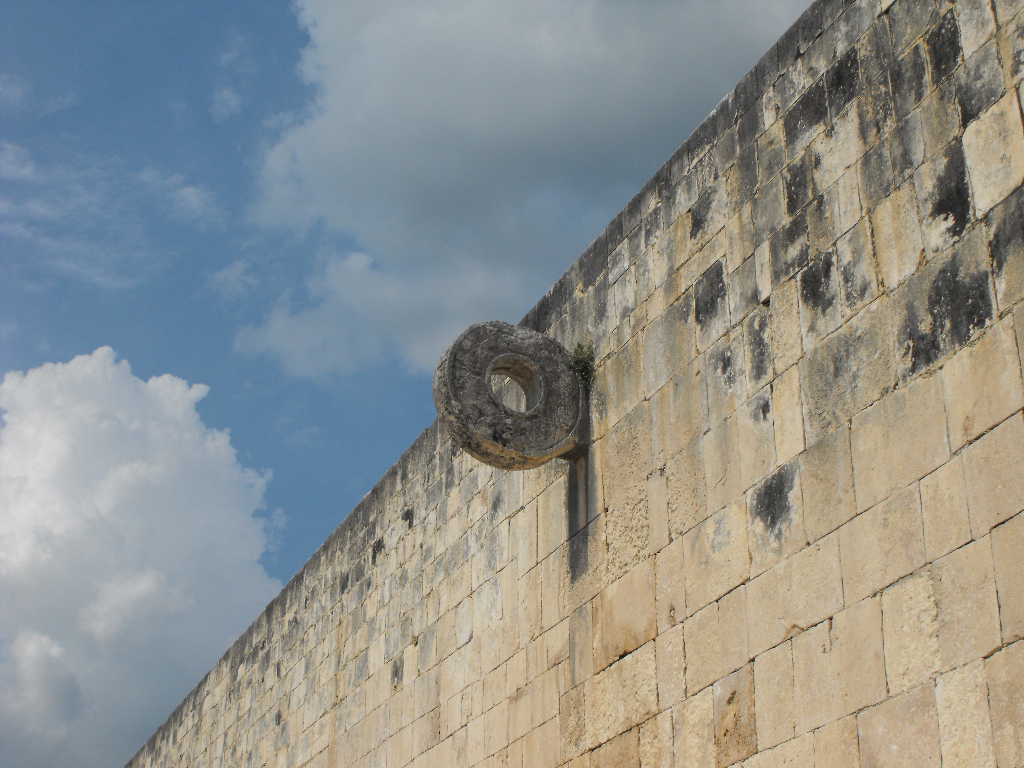
Here is a closer view of the Temple of the Bearded Man named for a carving inside it.
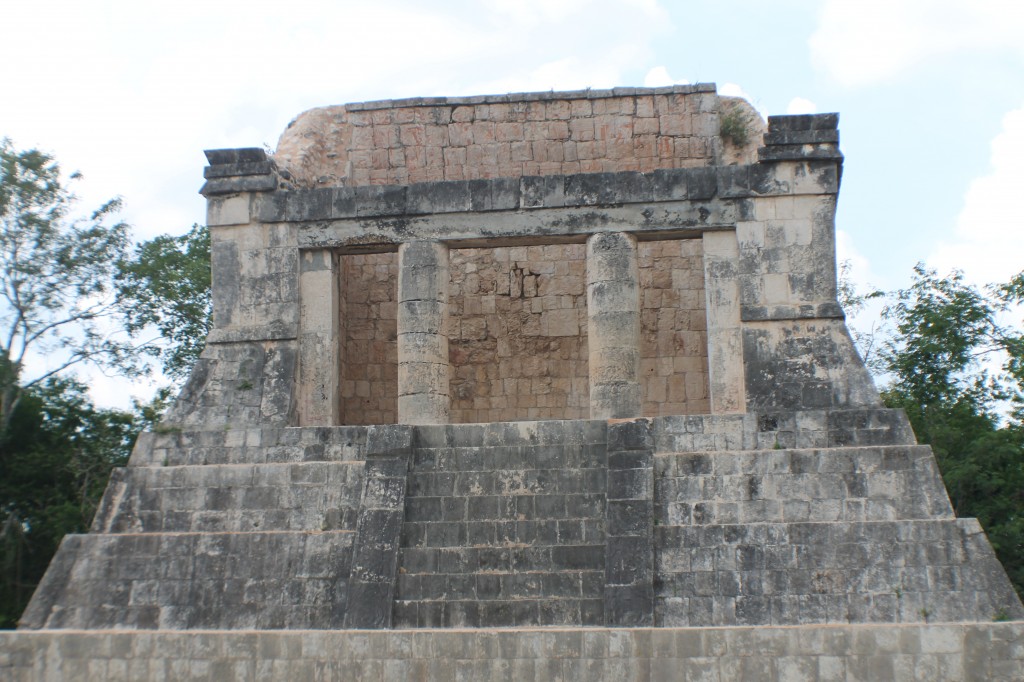
The Great Ball Court has a remarkable acoustic. A person speaking from the North Temple can be heard clearly at the opposite end at the South Temple, about 443 feet away. Here is the South Temple on the picture.
A closer view of the South Temple. It is believed that the spectators present in this temple were the participants as well.
The Upper Temple of the Jaguars sits atop of the wall at the south-eastern end of the Ball Court.
Priests and other officials could get a commanding view of the play on the Ball Court from this perch of the Upper Temple of the Jaguars. Jaguars were powerful symbolic creatures in Mesoamerica, and particularly among the Maya.
An interesting fact that on Oct.5, 2012 Mexico’s National Institute of Anthropology and History released the image, which shows a section of a ceremonial ball court at the temples of Chichen Itza on the Yucatan Peninsula, Mexico. Mexican archaeologists say they have determined that the ancient Mayas built watchtower-style structures atop the ceremonial ball court to observe the equinoxes and solstices, and they said that the discovery adds to understanding of the many layers of ritual significance that the ball game had for the culture. A team of archaeologists confirmed that the sun shone through the slit-like openings when the setting sun touches the horizon at the winter solstice. Stairways to the structures are being restored so visitors can observe the phenomenon. Read more on SunHerald.com. Here is the image of the watchtower-style structure taken during our visit to Chichen itza.
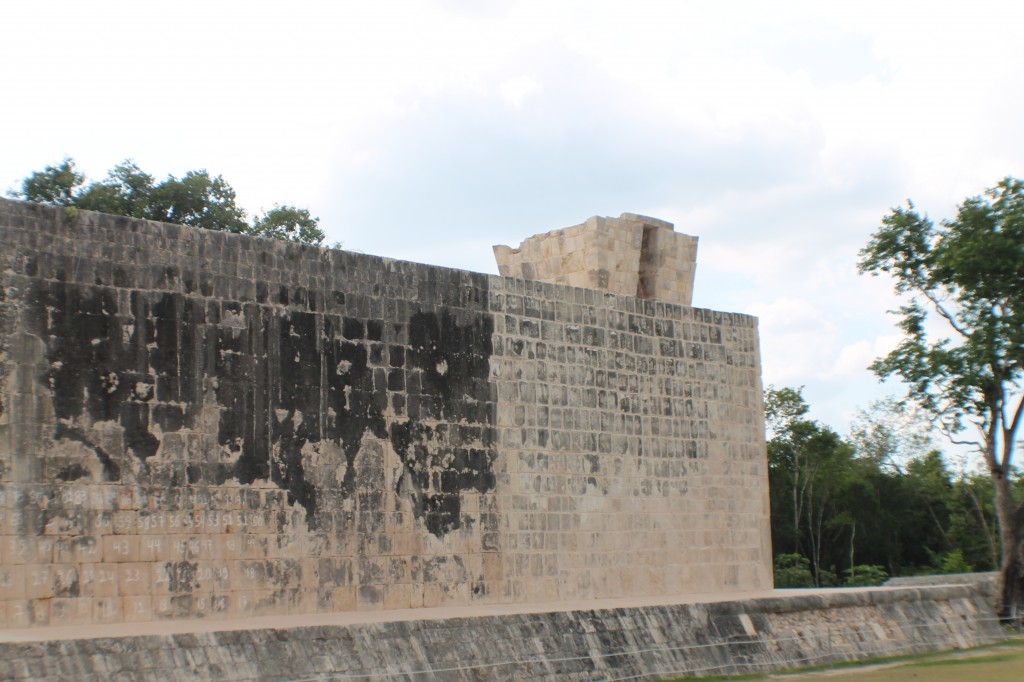
Here is one more watchtower-style structure in the middle of the wall of the Great Ball Court.
Shaped like an immense “I”, the court is bounded on both sides by high stone walls terminated by the Serpent Heads. We took plenty of pictures next to the serpent head. 🙂
Depending on the view angle, the serpent from the ball court changes his position to the pyramid. In this picture, the serpent head is approaching the pyramid.
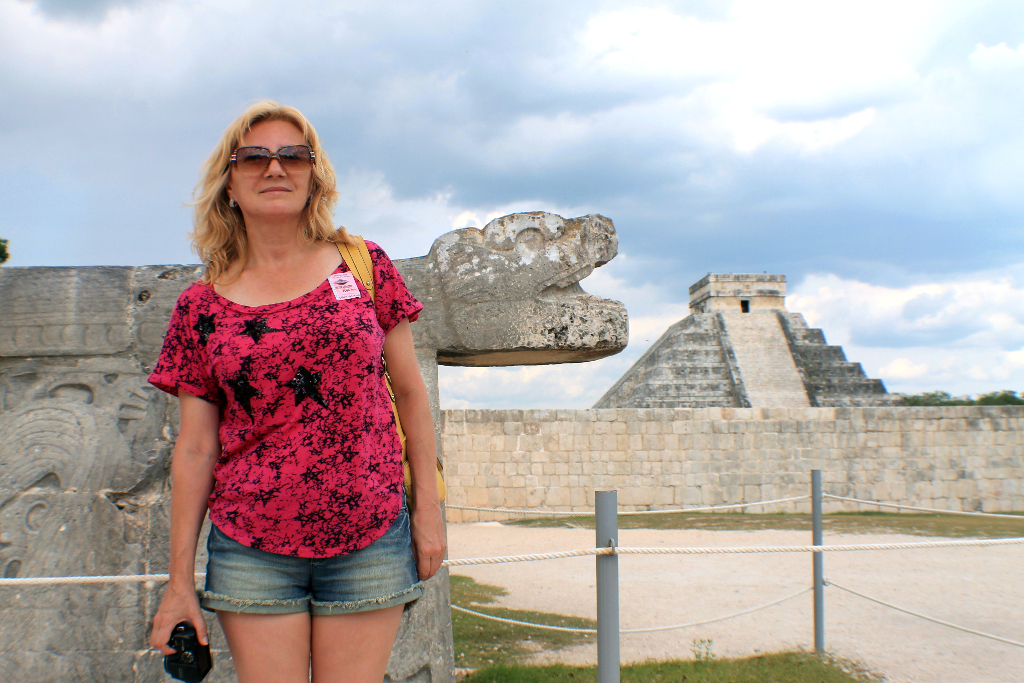
In this picture, the serpent protruding from ball court stadium appears to devour Kukulcan pyramid.

The opposite Ball Court wall was terminated with a stone snake head as well.
This is the Tzompantli or the Platform of the Skulls devoted exclusively to death. As the name implies, this platform displayed the skulls of all sorts of unfortunate people: war captives, sacrificial victims, the winners and losers of the ritual games played in the Great Ball Court next-door.
Platform of the Eagles and the Jaguars. Jaguars and eagles were considered to be extremely powerful creatures by the Maya. The warriors adorned themselves in jaguar skins and eagle feathers to absorb their power when going into battle. Access to this platform was gained in ancient times via four identical staircases, one located on each side and topped by twin snake heads. The sculptures of spotted jaguars and sharp-clawed adorned on the walls, showing the animals eating human hearts. Climbing the platform is not permitted nowadays .
The Platform of Jaguars likely served as a stage for ritual ceremonies and dances. This is easy to imagine because the platform’s flat top are visible from all sides.
We saw several stone snake heads on the grounds of Chichen Itza. Here is one of them in the picture.
The same pretty Arch at the entrance to Mayaland hotel from the Main Plaza of Chichen Itza.
Back to the Mayaland hotel.
Relaxing in the hotel before the Light and Sound show.
An acquaintance with the hotel’s inhabitant. It felt great after the pool. 🙂
Boxed meals had been provided for us before the show.
The Light and Sound show was about to begin. Since the artificial simulation of the equinox was created during the show, below I posted the images of the pyramid on a normal day, on the equinox and on a simulated equinox for comparison.
North stairway with serpent heads at base on normal days.
During the equinox the sun casts its rays on the pyramid, forming seven isosceles triangles that resemble the body of a serpent 37 yards long slithering downwards until it joins the huge serpent’s head carved in stone at the bottom of the stairway. It is said this snake is trying to make it to the well of sacrifice which is in the same direction. Corner of Kukulcan pyramid casts a shadow of a serpent’s body on the north stairway during sunrise and sunset on spring and fall equinox. This picture shows the Pyramid El Castillo at Spring Equinox. Below that is a picture of the artificial simulation of the equinox.
The light and Sound show began around 7 p.m. and lasted about an hour. We were all seated in the roped-off area facing Kukulcan pyramid at the distance and ready to enjoy the show. The show was full of history, light effects and a brief glimpse into the ancestry of the once powerful Mayan people. We watched mostly a projected light shadow over the architectural elements of the pyramid. The show narration was in Spanish, but headphones with translation in several languages were available for an additional charge. The narration of the Maya history, accompanied by music was interesting. The most effective was re-creation of the illusion of the descending serpent during equinox at the Light and Sound show. The temple of the Warriors and the Jaguar Temple were lighted briefly. The show was nice but not impressive. In my opinion, it was a little drawn out and needed more effects. It seems like the Chichen Itza Light and Sound show is currently unavailable due to reconstruction and will be available in 2013.
It took us only a couple hours to get to our hotel and we were sleeping the whole time on the way back. Overall, I found Chichen Itza a very interesting site and it is a must see. Of course, we haven’t seen even a half of the site. One day is, definitely, not enough. Oh, yes, about the end of the world. According to Mayans, no end of the world is expected. The date December 21, 2012 is regarded as the end-date of a 5125-year-long cycle in the Mesoamerican Long Count calendar, which will end the 5th cycle and start a new 6th cycle. Dave and I will be celebrating the End of the World anew in New York City, if we survive… 🙂 I hope, we all will survive!
